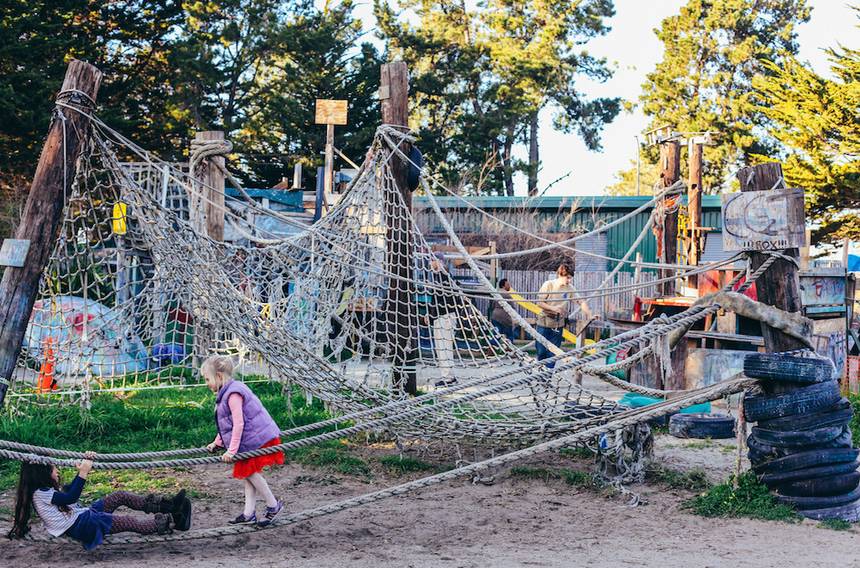Finally, designers fill it with loose parts.
最后,就是在游乐园里布置灵活组建啦。
These are the manipulatable objects — the planks, barrels, bricks, and tools — that fuel risky play.
也就是那些可操作的,会增加游玩冒险性的物体,如木板、木桶、砖块和工具。
The idea behind all these design elements is that kids respond well to being treated seriously:
所有这些设计元素背后的理念是,孩子们在受到认真对待时是能够做出良好的反应的:
if they’re presented with risky items with a serious functional purpose,
把带有严肃功能性目的的高风险物品放在他们面前时,
they’ll respond cautiously and conduct more experimentation.
他们是会很谨慎地应对,并进行更多的实验的。
But if presented with an overly safe, static space,
但如果把他们放到过于安全的静态空间里玩耍的话,
they often wind up seeking dangerous thrills that the built environment fails to provide,
他们往往会寻求当前的设施无法提供的危险刺激,
which can result in higher injury rates than risky play at adventure playgrounds.
这就可能导致比在冒险游乐园上进行冒险性的玩耍时更高的受伤率。
In the US, a culture of lawsuit-proof playscape design means that overly safe playgrounds are the norm.
美国这种“无法无天”的游乐园景观设计文化意味着过于安全的游乐场才是常态。
And design philosophy has focused on how to reduce height, movement, and hard materials.
游乐园的设计理念专注的也是如何降低高度、减少运动,减少硬质材料的使用。
That hasn’t made playgrounds better.
但这并没有让我们的游乐园变得更好。
When Marjory Allen visited American playgrounds in 1965,
1965年玛乔丽·艾伦考察了美国的多个游乐园,
she called them “an administrator’s heaven and a child’s hell.”
她当时称那些游乐园是“管理者的天堂,孩子们的地狱”。

But adventure playgrounds have recently begun to catch on in the US —
不过,冒险乐园最近已经开始在美国流行起来了——
perhaps due to an effort to introduce more unstructured play.
也许是得益于有关方在引入更多自由活动方面的努力。
And their construction comes with a fair share of criticism.
不过,这些游乐园在修建过程中也受到了相当多的批评。
“They’re making kids play with hammers and nails — that’s not adventure, it's just work.
“他们让孩子们玩锤子钉子——这不是冒险,这是在让孩子们干活。
They’re tricking kids into building their own playground.
他们是在哄骗孩子们自己打造游乐场。
Adventure playgrounds do have downsides:
冒险游乐园的确也有它的缺点:
They’re pretty ugly, they require a lot of space, and they need resources to staff and maintain.
它们样貌比较丑陋,需要占很大的空间,需要人力资源和维护资源。
And as with any playground, there is opportunity for injury.
而且,和任何游乐园一样,这里也有受伤的可能性。
But the underlying philosophy of risky play can help kids live better lives.
但冒险游戏的基本理念可以帮助孩子们过上更好的生活。
For one thing, riskier playgrounds encourage more activity.
一方面,游乐场风险高,会刺激孩子们更多地参与活动。
A study comparing playgrounds in London, where risky play spaces are popular, to those in San Francisco, Los Angeles, and New York
一项研究比较了伦敦的游乐园,在伦敦,冒险游乐园是比较受欢迎的,和旧金山、洛杉矶和纽约的游乐园,
found that children using London’s playgrounds were up to 18 percent more physically active.
发现伦敦游乐园玩耍的孩子们的身体活动频率要高18%。
The London playgrounds were cheaper and boasted fewer injuries, too.
伦敦的游乐园更便宜,而且受伤人数也更少。
And multiple studies have shown that children who engage in risky play have better risk detection, creativity, and self esteem.
多项研究表明,参与冒险游戏的儿童具有更好的风险识别能力、创造力,自尊心也会更强一点。
The playground is one of the only kinds of architecture designed specifically for children.
游乐园是为数不多的专为孩子设计的建筑之一。
And if the standard model we’ve decided on is seen as boring by its users — that’s a problem.
如果我们认为标准的游乐园模式在其使用者眼里却是无聊的,那就说明它是有问题的。
Better design can fix that — even if it’s a little risky.
更好的设计,即便是冒险一点的设计,就能解决这一问题。











